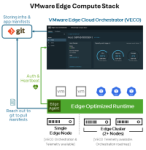For healthcare providers, the ability to respond fast has always been key to delivering better patient outcomes. But when the COVID-19 crisis broke out, the Alaska Native Tribal Health Consortium (ANTHC) was forced to take its processes to an entirely new level. This non-profit healthcare group offers a wide range of services to Alaska Native and Native American people. More than 180,000 people depend on the organization for medical services, disease research and prevention, water and sanitation systems construction, and more. Its IT team had to act quickly to enable testing, telehealth, and other urgently needed services.
VMware and its partner step up to the challenge
ANTHC turned to its trusted technology partner, GCSIT, for help. This VMware partner acts as a personal technology optimization team to help customers create and maintain custom-built infrastructures that can quickly adapt to new needs.
To establish consistent, high-quality connectivity for essential health systems, GCSIT recommended VMware SD-WAN™. This solution lets ANTHC use its existing network and Internet transport to support bandwidth-hungry applications at all its sites, from its headquarters to branch offices and remote clinics. For latency-sensitive apps like videoconferencing, voice communications, and access to medical records, VMware SD-WAN provides quality of service (QoS) and traffic shaping.
For locations that had no Internet service at all, GCSIT deployed the VMware SD-WAN Edge 510-LTE. Now rural sites can connect to ANTHC services using an integrated LTE modem, or AT&T mobile hotspot devices.
Accelerating service delivery, today and tomorrow
Together, VMware and GCSIT helped ANTHC ensure top-quality healthcare services across all the areas it serves. Every day counts in a crisis, and the ability to roll out the solution fast was an area where SD-WAN truly shined.
“Within a day, we were able to provide access back into the network using the AT&T MiFi devices,” said Nick Perry, Network Telecommunications Manager at Alaska Native Tribal Health Consortium. “Employees were able to access the EHR, the phone, printing, and all our other services and applications from day one without any issues. We have designed it for our alternate care sites, just in case we have to deploy something out to one of those locations, as well as our testing centers that don’t have a circuit available in the area.”
With the SD-WAN solution up and running smoothly, ANTHC has gained a replicable template that it can push out to other remote locations that need healthcare services, regardless of the type of transport they are using. At the same time, GCSIT has gained a tested, proven solution that it can use as a blueprint for other rural customers.
“There are a lot of companies in our region that that support multiple villages and don’t have the type of connectivity they need,” said Jeremy Wherle, Account Executive with GCSIT. “This initiative is a stepping stone that sets up conversations about how we could serve those potential customers.”
To learn all the details about how ANTHC improved the delivery and quality of its healthcare services, read the full case study.
Learn more
Visit our Care at the Edge page to find out how VMware SD-WAN is optimizing telehealth, remote and mobile clinics, healthcare IoT devices and more.







